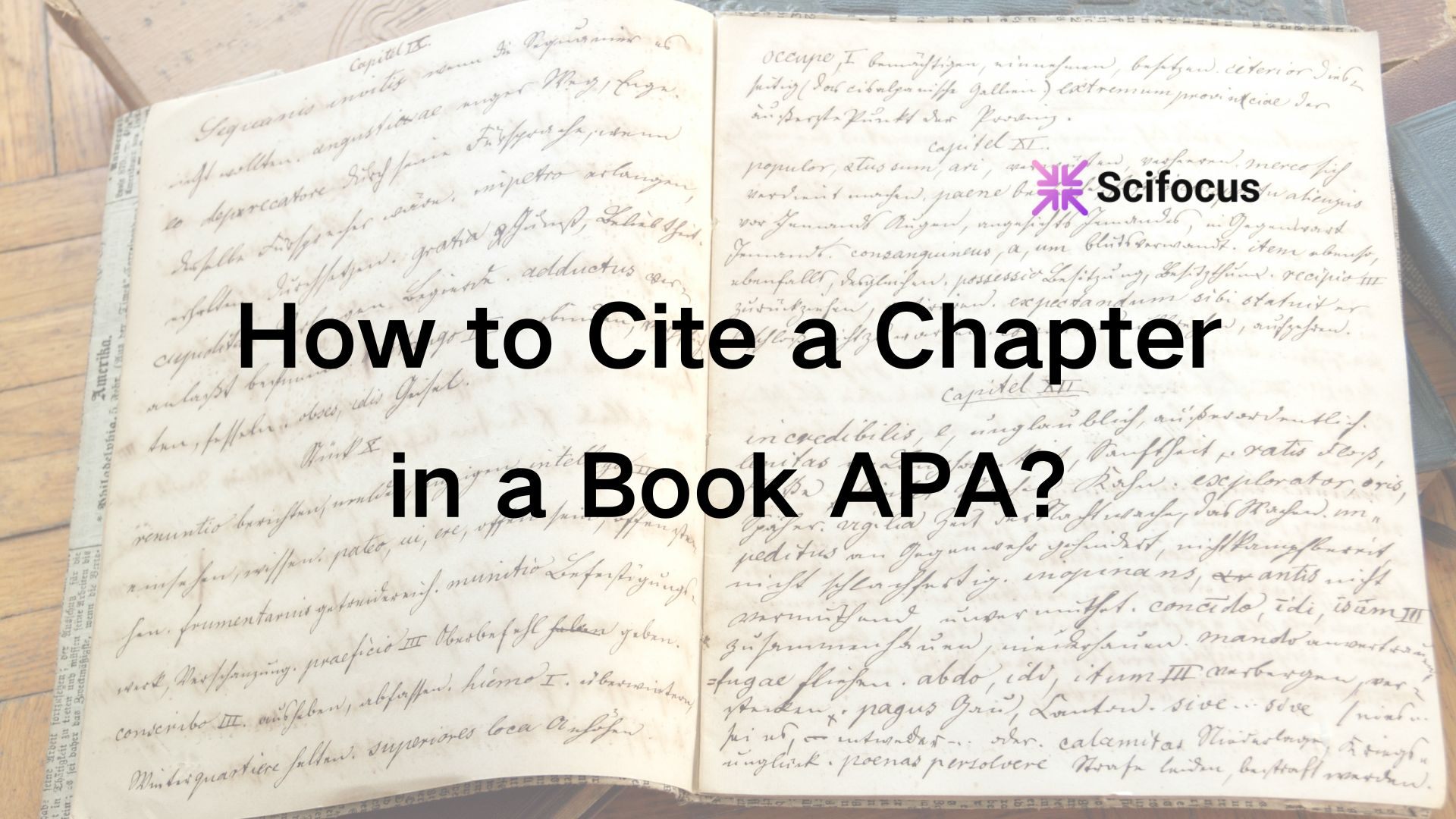Table of content
How to Cite a Chapter in a Book APA?

When citing a chapter in a book using APA format, the correct approach is to include the chapter author(s), year of publication, chapter title, editor(s) of the book, book title, page range of the chapter, and publisher. The reference list entry follows this structure:
Reference format:
Author(s). (Year). Chapter title. In Editor(s) (Ed(s).), Book title (pp. xx–xx). Publisher.
APA Style Reference Examples
In-text citation:
- Parenthetical: (Author, Year, p. xx)
- Narrative: Author (Year) states that … (p. xx)
Example:
- Reference list:
Smith, J. (2020). Modern genetics. In J. Doe (Ed.), The Biology Handbook (pp. 45–78). Science Press.
- In-text: (Smith, 2020, p. 50)
For efficient APA citation management, researchers can utilize Scifocus , which automates reference formatting and ensures consistency across chapters, books, and journals. To explore more citation techniques and resources, see the Scifocus blogs.
For automated generation of APA chapter citations, the Scifocus Citation Generate Tool provides step-by-step guidance, ensuring your references are consistently accurate.
What Are the Key Elements of an APA Chapter Citation?
Accurate chapter citation requires understanding the key components. The following table summarizes each element:
| Element | Description | Example |
|---|---|---|
| Author(s) | Individual(s) who wrote the chapter | Smith, J. |
| Year | Publication year of the book | 2020 |
| Chapter Title | Title of the specific chapter | Modern Genetics |
| Editor(s) | Person(s) who edited the book | Doe, J. |
| Book Title | Title of the book (italicized) | The Biology Handbook |
| Page Range | Pages of the chapter | pp. 45–78 |
| Publisher | Name of the publishing company | Science Press |
| DOI (if applicable) | Digital Object Identifier for e-books | 10.1234/biology.2020 |
For an overview of citation standards across formats, including APA vs MLA, check out APA vs MLA Key Differences. This helps contextualize chapter citations within broader academic writing practices.
How Do You Format the Reference List for a Chapter?
According to the Purdue Online Writing Lab (OWL), a chapter reference follows this pattern:
- Begin with the author’s last name and initials.
- Add the year of publication in parentheses.
- Include the chapter title in sentence case.
- Insert “In” followed by the editor(s) and “(Ed.)” or “(Eds.)”.
- Italicize the book title.
- Add the page range in parentheses.
- Finish with the publisher name.
Example:
Brown, L., & Green, M. (2018). Advances in neuroimaging. In P. White & R. Black (Eds.), Neuroscience Today (pp. 101–125). Academic Press.
In-text citation:
- Parenthetical: (Brown & Green, 2018, p. 110)
- Narrative: Brown and Green (2018) state that … (p. 110)
How Are In-Text Citations Structured for Chapters?
In-text citations vary depending on the number of authors and the citation style.
| Scenario | Parenthetical | Narrative |
|---|---|---|
| One author | (Smith, 2020, p. 50) | Smith (2020) argues that … (p. 50) |
| Two authors | (Brown & Green, 2018, p. 110) | Brown and Green (2018) state that … (p. 110) |
| Three or more authors | (Taylor et al., 2019, p. 75) | Taylor et al. (2019) found that … (p. 75) |
Note: Always include page numbers when quoting directly. For paraphrasing, page numbers are recommended but optional.
When Should Single vs Double Quotation Marks Be Used in APA?
APA defines quotation mark usage clearly:
- Double quotation marks (“ ”) are used for direct quotations.
- Single quotation marks (‘ ’) are used for a quote within a quote.
Example:
According to Smith (2020), “Neuroplasticity is ‘the brain’s ability to reorganize itself’ over time” (p. 52).
Comparison with MLA and British English:
- MLA uses double quotes for all direct quotes, single only for quotes within quotes.
- British English often reverses this order, starting with single quotation marks.
What Are Common Mistakes When Citing a Chapter?
Even experienced writers make citation errors. Common issues include:
- Citing the entire book instead of a chapter.
- Forgetting to mention editors.
- Skipping the page range.
- Incorrect italicization.
- Misplacing the publication year.
| Mistake | Incorrect Example | Correct Example |
|---|---|---|
| Missing editor | Smith, J. (2020).Modern Genetics. Science Press. | Smith, J. (2020). Modern genetics. In J. Doe (Ed.),The Biology Handbook(pp. 45–78). Science Press. |
| No page range | Brown, L. & Green, M. (2018).Neuroscience Today. Academic Press. | Brown, L. & Green, M. (2018). Advances in neuroimaging. In P. White & R. Black (Eds.),Neuroscience Today(pp. 101–125). Academic Press. |
| Wrong italics | Chapter title in italics | Book title in italics |
For more citation troubleshooting, see the Harvard Writing Center: Citing Sources.
How Do You Cite Electronic Chapters and DOIs?
Digital books have become increasingly common. APA provides clear guidelines:
- Include DOI if available.
- If no DOI, provide the publisher URL.
- Maintain the author-editor-book structure.
Example with DOI:
Nguyen, T. (2021). Cognitive behavioral therapy techniques. In R. Patel (Ed.), Modern Psychology (pp. 33–60). Springer. https://doi.org/10.1007/978-3-030-12345-6
Automated tools like Scifocus Citation Generate Tool can handle DOI insertion automatically.
Are There Special Cases to Consider?
Certain conditions require modification:
- No chapter author: List the editor as the author.
- Multiple editors: Use “Eds.” for plural.
- Translated chapters: Include translator after book title.
- Reprinted chapters: Include both years (original and reprint).
Example (Reprint):
Johnson, R. (2015/2020). Early childhood development theories. In S. Lee (Ed.), Foundations of Education (pp. 12–34). Routledge.
For more nuanced cases, the APA Style Manual, 7th Edition provides full reference models.
Why Is Accurate APA Citation Important?
Proper citation ensures:
- Credibility: Demonstrates your sources are reliable.
- Reproducibility: Readers can locate sources accurately.
- Plagiarism prevention: Gives proper credit.
- Clarity: Structured references improve readability.
Using tools like Scifocus streamlines citation management and integrates seamlessly with research workflows. For practical guides and insights on citation practices, consult the Scifocus blogs.
FAQs
How do I cite a chapter from an edited book in APA?
Use: Author(s). (Year). Chapter title. In Editor(s) (Ed(s).), Book title (pp. xx–xx). Publisher. Include DOI if available.
What if the chapter has multiple authors?
List all authors in the reference. In-text: “&” for two authors, “et al.” for three or more.
Should I include page numbers in in-text citations?
Yes, required for direct quotes, recommended for paraphrasing.
How do I handle chapters without page numbers?
Omit page range in references; use paragraph numbers (para. xx) for quotes if available.
What’s the difference between single vs double quotation marks in APA citations?
Double quotes: direct quotations; single quotes: quote within a quote. For examples, see Scifocus blog:When to use single quotation marks.
Proper APA chapter citation may seem complex, but by following structured guidelines and using tools like Scifocus, students and researchers can maintain accuracy, efficiency, and consistency in their writing. Additionally, exploring the Scifocus Citation Generate Tool allows instant formatting, reducing time spent on reference lists while supporting high-quality scholarly work.
Did you like this article? Explore a few more related posts.
Start Your Research Journey With Scifocus Today
Create your free Scifocus account today and take your research to the next level. Experience the difference firsthand—your journey to academic excellence starts here.
